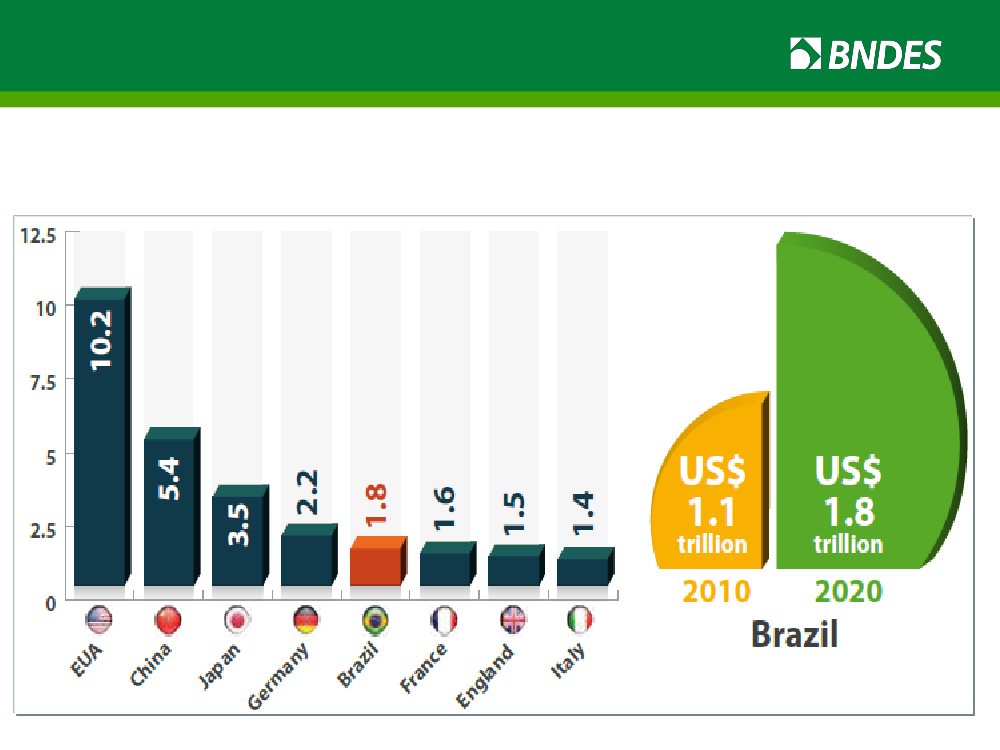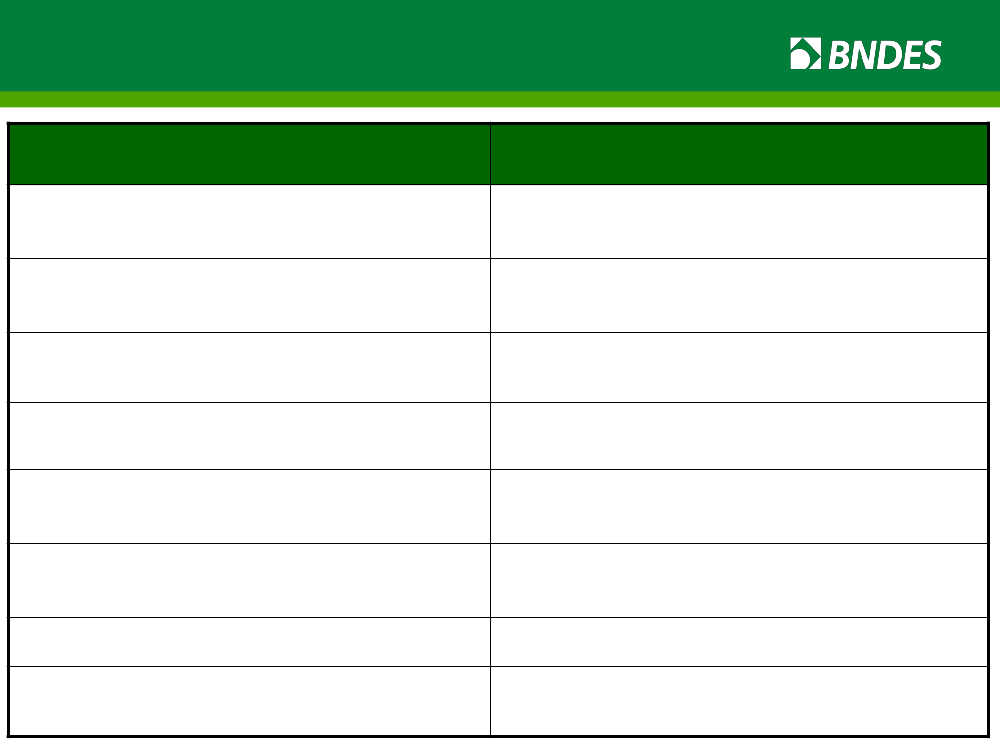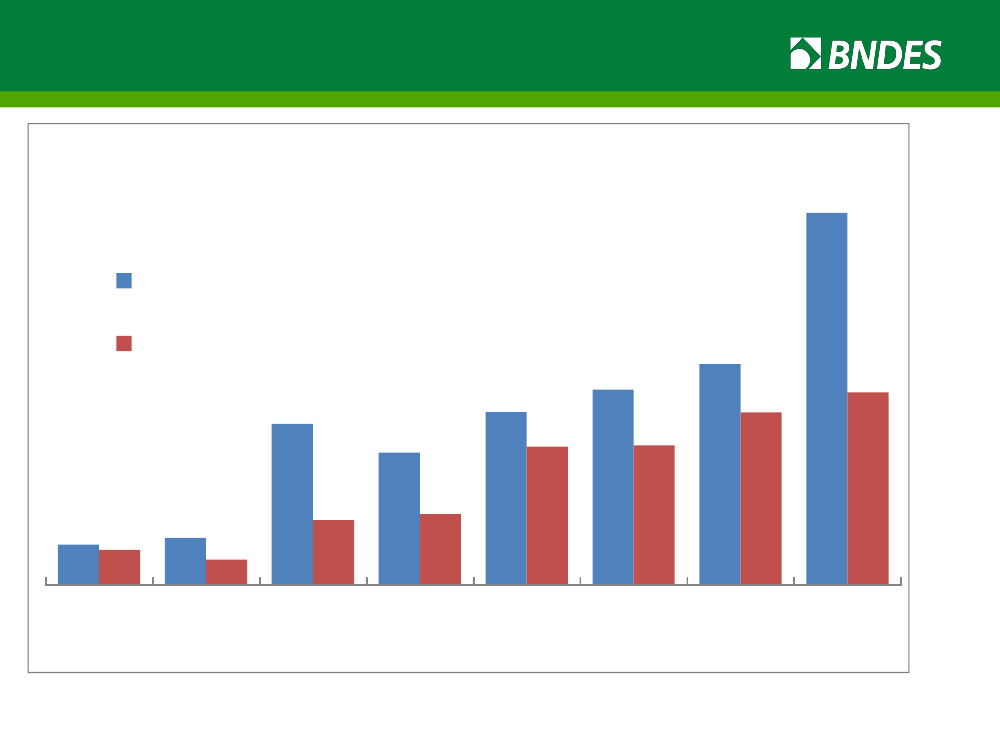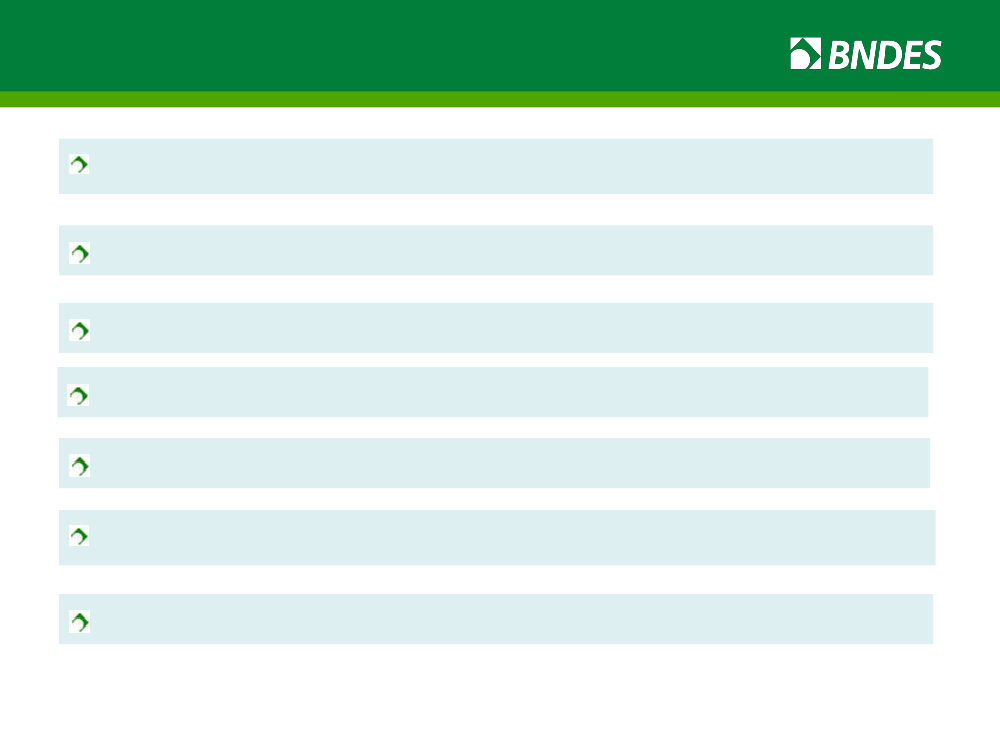Erhvervs-, Vækst- og Eksportudvalget 2012-13
ERU Alm.del Bilag 204
Offentligt
Brazilian EconomyRio de JaneiroMarch, 2013
1
The Brazilian economy is able to reachsustainable growthDomestic market leading economic growthEconomic PolicyPolicies for social inclusionInflation targetingSound fiscal policyFloating exchange rate with reduced volatilityUse of financial and regulatory instrumentsMeasures to boost competitiveness
Good external solvency indicators
A robust banking sectorMany investment opportunities :Agribusiness, Oil & Gas, Logistics, Energy, Domestic MarketLed Investments, World Sport Events ...
Low unemployment rate with aconsistent job creation
Unemployment Rate (%)
Net Jobs Creation(thous. of jobs)
(*) On 12 month basis up to Sept. ‘12
Source: IBGE.PME and Caged. Produced by APE/BNDES
3
Economic inclusion creating a dynamic marketPopulation by income class strata (# of people)*
* Source: IPEA, based on PNAD/IBGE data. Prepared by Ministry of Finance
4
Brazil will be the fifth largestglobal market in 2020Global Consumer Market(US$ trillion)
Source: McKinsey.
5
Sound macroeconomic fundamentals:Declining Net Public Debt/GDPConsolidated Public Sector Net Debt(% of GDP)
Source: Brazilian Central Bank.
6
Increasing public sector investmentsPublic Sector Investments(% of GDP)
Source: IPEA.
7
Sound macroeconomic fundamentals:Inflation under controlCPI Inflation(IPCA index, % YoY)
Source: IBGE.
8
Sound macroeconomic fundamentals:Strength of the external sectorInternational Reserves(US$ billion)
Source: Brazilian Central Bank
9
FDI at highest levelsForeign Direct Investment - FDI(US$ billion)
•Source: UNCTAD
•Fonte: UNCTADElabora§ão: Ministério da Fazenda10
Expected business growthCountries where companies expect to expand their business(% of total answers)
Brazil:the third most mentionedcountry for expanding businessover the next 12 months
* “Dealing with disruption, adapting to survive and thrive”, (survey with more than 1,300 CEOs*)PricewaterhouseCoopers, 16th Annual Global CEO Survey, January 2013, p.12.
11
BNDES
12
BNDES HighlightsFounded on June 20th, 1952100% state-owned company under private lawKey instrument for implementation of FederalGovernment’s industrial and infrastructure policiesMain provider of long-term financing in BrazilEmphasis on financing investment projectsSupport to micro, small and medium-sized companiesBrazilian Export Bank13
The BNDES role in Brazilian developmentCountry challengesInvestment growing ahead of GDP
The Role of the BNDESSupport for new capacity, especially in hightechnology sectors and innovation
Continuity and expansion of investment ininfrastructureExpansion of exportsLabor force skills strengtheningDevelopment of a private, long-termfinancing industryImprovement of the governance in publicand private organizationsModernization of public institutionsPromotion of long-term planning and projectpreparation
Credit, project finance and guaranteesFinancing –supplier's creditFinancingSupport for bond markets; introduction of newfinancing instruments, technical supportTechnical supportFinancingTechnical support and financing14
Supporting Employment and InvestmentsInvestments supported and jobs created due to the BNDES20%25%Investiments supported by the BNDES /Total national investment (GFCF)20%
22,6%19,7%
21,7%15%
16,7%15%
10,8%
12,1%10,1%10%
10,9%
11,4%
12,5%
13,0%7,2%
9,9%
10,5%
9,8%
10%
5,3%5%
3,5%
3,9%
4,1%
4,4%
5%
Jobs created or maintained due to the BNDES /Total registered employment at the end of the year
0%
0%
2003Source: BNDES* BNDES Forecast
2004
2005
2006
2007
2008
2009
2010
2011
2012*15
An important counter-cyclical role in theBrazilian economyBNDES’ share in the Brazilian credit market was 20% in 2012.The private sector’s was 54.6% and other State-owned banks, 25.4%
16Sources: Brazil's Central Bank. Produced by APE/BNDES
BNDES has been the main source offinancing for infrastructure projectsSources of Resources in infrastructure and oil projects (2011)
Source: ANBIMA. *Example includes projects for roads, ports, SHS, Wind Parks and Oil Prospecting
17
BNDES Disbursements will increase
Source: BNDES
18
A strong demand for financing infrastructureBNDES Approvals & Disbursement for Infrastructure(US$ billions)
25.1
ApprovalsDisbursements10.98.93.24.41.7200720082009201020112012
11.79.34.8
13.2
14.911.713.0
9.4
2.72.42005
2006
For 2013 is expected a total disbursement of US$ 15 bi – an increase of 16%Source: BNDES19
InvestmentOutlook
20
Investments will reach at least US$ 1.9 trillion inthe coming 4 yearsBrazil’s Investment Outlook (2013-16)(US$ billion - Constant prices)
SectorsIndustryInfrastructureHousingAgriculture and ServicesTotalSource: BNDES
2008-2011
2013-2016
Δ (%)
CAGR %
434,4184,1305,6589,21.513,3
529,7257,1394,9776,11.957,8
21,939,729,231,729,4
4,06,95,25,75,3
(*) Note : The BNDES research on the investment outlook for 2013-2016 covers 66% of the total industrial investments, and 100% of investments ininfrastructure, totalizing about 58% of the investments in the economy (excluding residential construction). Agriculture and Services investments are21based on queries to Sectorial entities and/or econometric forecast.21
Investments in logistics will increase 123% inthe coming 4 years(US$ Billion)
SectorsInfrastructureElectricity*Power GenerationTransmissionDistribution
2008-2011
2013-2016
Δ(%)
184.182.252.56.922.8
257.191.357.213.620.5
39.711.09.097.1-10.020.124.971.8182.6150.1170.9
TelecommunicationsSanitationHighwaysRailwaysPortsAirports
43.517.420.514.05.01.7
52.221.735.239.412.54.7
Logistics
*It represents an expansion of80,4of power capacity and 23,600 Km123,044.5 GWTransmission LinesLogística179,2
41.2
91.9
123.022
Source: BNDES
Investments in the World Cup also stand apartInvestments: 2014 World Cup(US$ billion)
Source: Ministry of SportsElaborated by: Ministry of Finance
23
2013-2016: BNDES’ Investment Surveyat its highest levelInvestment Outlook 4 years ahead(Comparable Sectors - US$ billion - 2012)5505305104904704502008-20112009-20122010-20132011-20142013-2016
535,92012-2015
512,3475,4439,1
441,12007-2010
430410390370350
419,8
391,1
2006
2007
2008
2009
2010
2011
2012
Base year of BNDES SurveySource: BNDES Investment Survey
24
Fostering investments
Monetary easing(SELIC rate down 525 bsp since Aug. ‘11)Reduction in the long-term interest rate (TJLP)Falling energy costsTax cuts(relieffor employers’ payroll contributions, reform of VAT, IPI reduction)Public investment acceleration(PAC and My House, My Life)New concessions to private sector in logisticshighways, railways, ports, airports
25
Long-term challenges
Eradicate poverty and create opportunities for social mobility
Raise domestic saving ratesDiversify long-term financing sources
Improve Brazilian industry competitivenessFoster innovation and sustainabilityIncrease labor productivity and income
More investments on infrastructure26
Brazilian EconomyMar, 2013
27



























